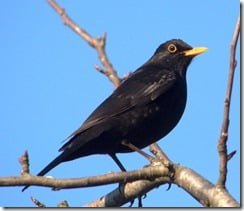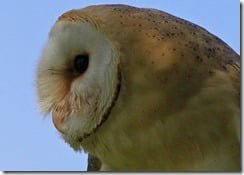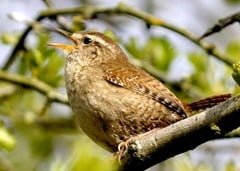 The blackbird is a ubiquitous bird of Irish parks and gardens, and is a common sight everywhere from the heart of our largest cities to the remotest rural setting. Originally a woodland bird the blackbird now exploits the wide variety of habitats presented to it by people. The species does very well on agricultural land and in urban centres, but it is suburban gardens that have allowed the blackbird to really thrive.
The blackbird is a ubiquitous bird of Irish parks and gardens, and is a common sight everywhere from the heart of our largest cities to the remotest rural setting. Originally a woodland bird the blackbird now exploits the wide variety of habitats presented to it by people. The species does very well on agricultural land and in urban centres, but it is suburban gardens that have allowed the blackbird to really thrive.
Blackbirds are without doubt one of our most familiar birds, with recent estimates putting the breeding population in Ireland at 1,800,000 pairs. A member of the thrush family the blackbird epitomises the typical thrush body shape. Adult birds are about 25cm (10 inches) long. The males are unmistakeable with their jet black plumage, bright yellow bill and prominent yellow circle around the eye. Females look a uniform dark brown from a distance, but a closer look will reveal a slightly lighter breast with a faint mottled pattern. Juvenile birds resemble the females but are more rufous in colour with more prominent markings on both the breast and back.
Leucism (an abnormality in the development of pigment cells) is a relatively common phenomenon in blackbirds and it’s not unusual to see male birds sporting the occasional patch of white plumage. Fully leucistic individuals are quite rare, as their striking white plumage makes them very conspicuous to their predators, but they do occasionally occur.
The blackbird’s rich, warbling song is punctuated by frequent pauses and is a familiar sound across the country from early spring onwards. Although these birds spend a good deal of their time on the ground, males tend to find a prominent vantage point like a high branch, chimney breast or television aerial before bursting into song. Blackbirds also have a very distinctive “tut-tut” alarm call that they emit either singly or as an impressively cacophonous volley when danger threatens, alerting not only other blackbirds to the potential threat, but practically everything else in the vicinity as well.
Blackbirds feed on a wide variety of foodstuffs, from seasonal berries to worms, grubs, insects and kitchen scraps. They generally forage on the ground, and are a common sight hopping across garden lawns and parkland, head cocked to one side as they eye up a potential meal. The noisy rustling of leaf litter from the base of a hedge or amongst the undergrowth during the autumn is usually a sign that blackbirds are rooting around for grubs and insects.
Male blackbirds are very territorial and defend their patch vigorously against rivals during the breeding season. When a female blackbird is at her most fertile the male never leaves her side, guarding her closely to make sure that she doesn’t mate with a rival in his absence. The breeding season starts in early spring and continues late into the summer, and a typical pair will produce two or even three broods of young in that time.
Blackbirds build their nests of twigs, leaves, grass, mud and moss in a wide range of locations including trees, hedges, thickly foliaged shrubs and occasionally in more unorthodox places such as garden sheds. A clutch of 4-5 light blue eggs with red speckles is laid and incubated for 11-17 days. Once hatched the young birds are fed by both parents and fledge after roughly two weeks. The parent birds will continue to care for their offspring until they are capable of foraging for themselves.










11 comments
chris
i have blackbirds all over the place we???????????????????????????????????????????????? and all the rest
clare
i ???? wild life
Carmel
Hi,
I had a blackbird build its nest in the shrubbery at the bottom of my garden. I peered in once or twice and now the Mom and Dad blackbird have left!!! No eggs…..did I scare them away….?
Malachi O'Sullivan
Very interesting, thank you very much. Could you possibly include the Irish name for the birds in your articles? It would certainly add to people’s knowledge. The Irish for blackbird is lon dubh
Tamas
What can I do if I found one (black bird/turdus merula) standing in my garden, hardly moving…still standing and weighs relatively little…? No visible injuries…just not very alert…thanks
Danielle
I saw this too. I was wondering if it was sick or just enjoying the sunshine but it looked really out of it.
Swav
Great post… this bird is showing up in my garden whenever I start to do some painting 🙂 It’s good to know that he likes berries… I might have to consider this kind of salary for him
Edel Nic Suibhne
Hi Calvin,
I’m living in the city in Galway, and every year I have a blackbird that nests in shrubbery that climbs the wall at the end of my garden, It produces bright red berries and I’ve seen him (it’s’ a male – bright yellow beak, black plumage) eat the berrries while hopping around on the grass. Am wondering is it the same bird returning every year??!! Or is it the berries that attracts them? Either way it is very pleasurable watching him every morning, but there are lots of cats around so am very nervous for him. However none of the cats have caught him yet, I wonder is it the same one that is returning each year.
Calvin Jones
It could be the same bird returning to the same nesting location year-on-year — but they are very unlikely to use the same nest — preferring to build a new one.
It’s hard to say for sure but it’s quite likely that the bird you see eating berries in your garden in autumn / early winter is a different bird entirely — quite possibly a foreigner. Our resident blackbird population is swelled by visitors from northern Europe in autumn.
Hope that helps.
Aaron Yeatman
When was this article written? What year?
Calvin Jones
Hi Aaron… I originally wrote the article as a species profile for the back page of the magazine “Ireland’s Own” — I’m not sure exactly when off the top of my head, but suspect it was around 2003/2004.